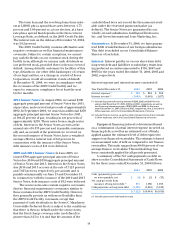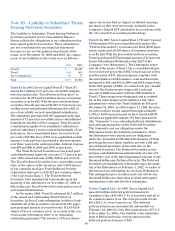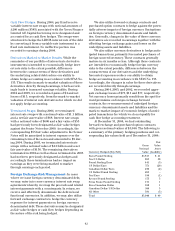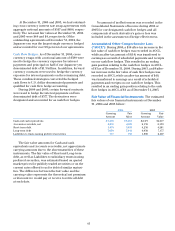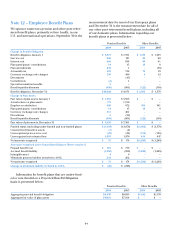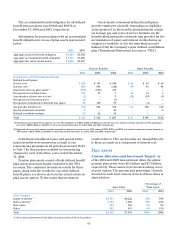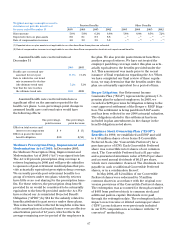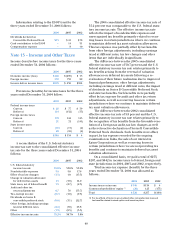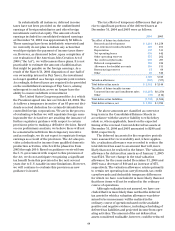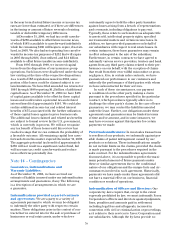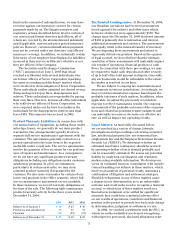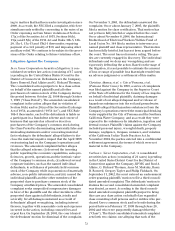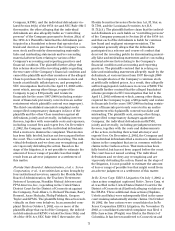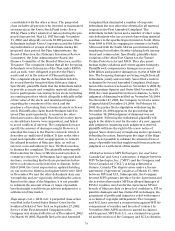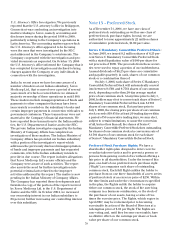Xerox 2004 Annual Report Download - page 71
Download and view the complete annual report
Please find page 71 of the 2004 Xerox annual report below. You can navigate through the pages in the report by either clicking on the pages listed below, or by using the keyword search tool below to find specific information within the annual report.
69
In substantially all instances, deferred income
taxes have not been provided on the undistributed
earnings of foreign subsidiaries and other foreign
investments carried at equity. The amount of such
earnings included in consolidated retained earnings
at December 31, 2004 was approximately $6 billion.
These earnings have been indefinitely reinvested and
we currently do not plan to initiate any action that
would precipitate the payment of income taxes there-
on. However, as discussed below, upon completion of
our evaluation of the American Jobs Creation Act of
2004 (“the Act”), we will reassess these plans. It is not
practicable to estimate the amount of additional tax
that might be payable on the foreign earnings. As a
result of the March 31, 2001 disposition of one-half of
our ownership interest in Fuji Xerox, the investment
no longer qualified as a foreign corporate joint venture.
Accordingly, deferred taxes are required to be provided
on the undistributed earnings of Fuji Xerox, arising
subsequent to such date, as we no longer have the
ability to ensure indefinite reinvestment.
The United States Congress passed the Act, which
the President signed into law on October 22, 2004. The
Act allows a temporary incentive of an 85 percent divi-
dends received deduction for certain dividends from
controlled foreign corporations. Weare in the process
of evaluating whether we will repatriate foreign earn-
ings under the Act and weare awaiting the issuance of
further regulatory guidance with respect to certain
provisions prior to making a definitive decision. Based
on our preliminary analysis, webelievethere will not
be a material benefitfrom this temporary incentive
and accordingly, we do not expect to repatriate foreign
earnings as a result of the provision. The Act also pro-
vides a deduction for income from qualified domestic
production activities, which will be phased in from
2005 through 2010. Based on guidance received from
the U.S. government with respect to this provision of
the Act, we do not anticipate recognizing a significant
tax benefit from this provision for the next several
years due to U.S. taxable income limitations. However,
we will continue to evaluate this provision as new
guidance is issued.
The tax effects of temporary differences that give
rise to significant portions of the deferred taxes at
December 31, 2004 and 2003 were as follows:
2004 2003
Tax effect of future tax deductions
Research and development $ 1,281 $ 1,238
Post-retirement medical benefits 499 491
Depreciation 247 311
Net operating losses 450 442
Other operating reserves 333 262
Tax credit carryforwards 289 237
Deferred compensation 198 182
Allowance for doubtful accounts 149 151
Restructuring reserves 43 69
Other 40 340
3,529 3,723
Valuation allowance (567) (577)
Total deferred tax assets $ 2,962 $ 3,146
Tax effect of future taxable income
Unearned income and installment sales $(1,293) $(1,250)
Other (79) (112)
Total deferred tax liabilities (1,372) (1,362)
Total deferred taxes, net $1,590 $ 1,784
The above amounts are classified as current or
long-term in the Consolidated Balance Sheets in
accordance with the asset or liability to which they
relate or, when applicable, based on the expected
timing of the reversal. Current deferred tax assets at
December 31, 2004 and 2003 amounted to $289 and
$402, respectively.
The deferred tax assets for the respective periods
were assessed for recoverability and, where applica-
ble, a valuation allowance was recorded to reduce the
total deferred tax asset to an amount that will, more
likely than not, be realized in the future. The valuation
allowance for deferred tax assets as of January 1, 2003
was $524. The net change in the total valuation
allowance for the years ended December 31, 2004 and
2003 was a decrease of $10 and an increase of $53,
respectively. The valuation allowance relates primarily
to certain net operating loss carryforwards, tax credit
carryforwards and deductible temporary differences
for which wehaveconcluded it is more likely than not
that these items will not be realized in the ordinary
course of operations.
Although realization is not assured, we have con-
cluded that it is more likely than not that the deferred
tax assets for which a valuation allowance was deter-
mined to be unnecessary will be realized in the
ordinary course of operations based on the available
positive and negative evidence, including scheduling of
deferred tax liabilities and projected income from oper-
ating activities. The amount of the net deferred tax
assets considered realizable, however, could be reduced


